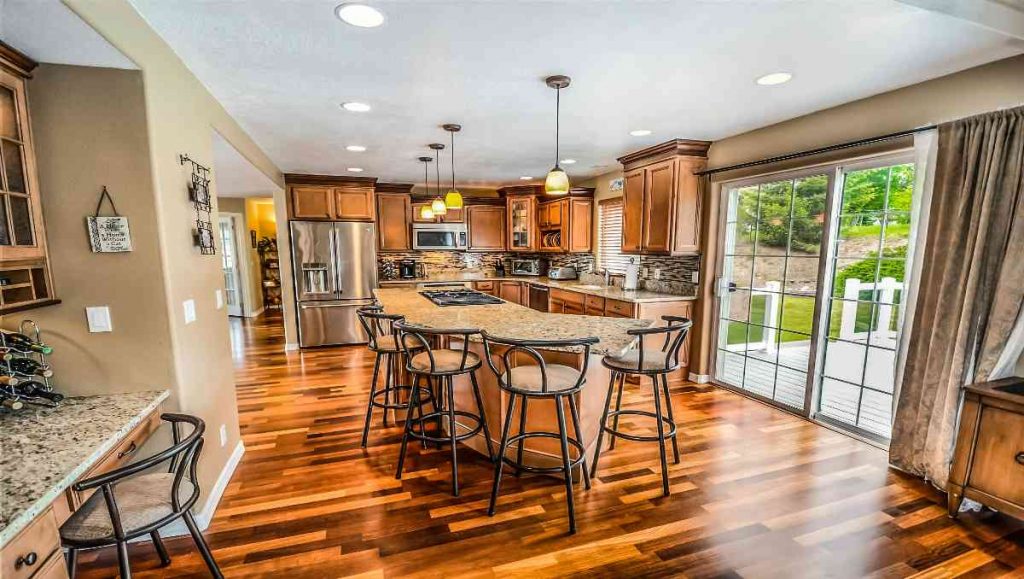
Amish-crafted furniture is renowned for its exceptional quality, durability, and timeless beauty. A crucial factor behind this enduring appeal lies in the selection of wood. Amish woodworkers carefully choose specific types of wood known for their strength, grain patterns, and ability to hold finishes.
Key Takeaways
- Amish furniture is made with great care using strong hardwoods like oak and cherry, which makes the furniture both beautiful and durable.
- Amish furniture is built to last for many years, often becoming a cherished family heirloom due to its sturdy construction and high-quality materials.
- Crafted from locally sourced solid hardwoods, this furniture benefits the environment while showcasing the wood’s natural beauty.
This article explores the preferred wood choices of Amish furniture makers, exploring their unique characteristics and why they are favored for crafting heirloom-quality pieces.
Popular Wood Types Used by Amish Craftsmen
Amish furniture making began in the 18th century when Amish communities migrated to America. Emphasizing self-sufficiency and simple living, they created practical, durable furniture for their homes. This tradition has evolved into the distinctive style recognized today, deeply rooted in their faith and values of simplicity, durability, sustainability, community, and humility.
Amish furniture makers choose hardwoods for their beauty, durability, and workability, often sourcing them locally to ensure sustainability. Each wood species adds unique characteristics, enhancing the furniture’s aesthetic and functional value. Below are some of the most favored woods in Amish workshops:
1. Oak
Oak, a hardwood staple in furniture making, is celebrated for its strength, durability, and distinct grain patterns. From light brown to reddish-brown hues, oak offers a wide range of color variations, making each piece unique. It readily resists dents and scratches, making it ideal for high-use furniture like dining tables and chairs. Its ease of working and ability to hold finishes contribute to its enduring popularity in the furniture market.
2. Cherry
Cherry wood is cherished for its warm reddish-brown color that deepens over time, creating a rich patina that enhances its beauty. Its smooth texture and fine grain make it a joy to work with, while its natural warmth adds a touch of elegance to any room. Amish craftsmen skillfully transform cherry wood into dressers, chests, nightstands, and dining sets, showcasing its timeless appeal. Looking for the best wood for your living space? Discover our exquisite collection of Amish chests & dressers, handcrafted from premium hardwoods and built to last.
3. Maple
Maple’s smooth, fine grain and light color provide a versatile canvas for Amish furniture builders. This hardwood is known for its exceptional durability and resistance to wear and tear, making it a popular choice for kitchen cabinets, dining tables, and chairs. Its dimensional stability and resistance to moisture ensure that maple furniture retains its shape and beauty for years to come.
You might be interested to read about cherry vs. maple wood comparison.
4. Walnut
Walnut, with its rich, dark brown color, straight grain, and occasional chocolatey streaks, is a prized wood for high-end furniture. It is often used for accent pieces, veneer, and decorative elements, where its luxurious appearance can be fully appreciated. While more expensive than other hardwoods, walnut’s enduring beauty and value make it a worthwhile investment for discerning consumers.
5. Hickory
Hickory stands out for its exceptional strength and shock resistance. It is the hardest of the commonly used hardwoods, making it a popular choice for furniture that needs to withstand heavy use. Amish craftsmen create sturdy and stylish chairs, bar stools, dining tables, and outdoor furniture from hickory, showcasing its rugged beauty and enduring resilience.
6. Quarter-Sawn White Oak
Quarter-sawn white oak is distinguished by its unique ray flake pattern, achieved through a specialized cutting method. This process not only enhances the wood’s aesthetic appeal but also improves its stability and resistance to warping and cupping. Quarter-sawn white oak is frequently used for tabletops, panels, and high-end furniture, where its beauty and performance are highly valued.
7. Mahogany
Mahogany, with its reddish-brown color, straight grain, and medium texture, is a favorite among furniture makers for its ease of working and finishing. It resists warping and is known for its durability. Mahogany is often used in high-end furniture, cabinets, and veneer, adding a touch of luxury to any space. Its enduring appeal ensures its popularity in both domestic and international markets.
Benefits of Using High-Quality Wood in Amish Furniture
The choice of high-quality wood is paramount in Amish furniture making, contributing to the pieces’ longevity, aesthetic appeal, and enduring value.
Longevity, Durability, and Sustainability
Amish furniture makers prioritize the use of hardwoods, renowned for their strength and resistance to wear and tear. This ensures that the furniture can withstand daily use and maintain its structural integrity for generations. Solid wood construction, combined with meticulous joinery techniques, creates furniture that can be passed down as cherished heirlooms.
The preference for wood in furniture, particularly oak, remains strong among consumers, as evidenced by research conducted in Kayseri, Turkey. This preference underscores the enduring appeal and value of solid wood furniture. Additionally, the utilization of wood aligns with the growing emphasis on sustainable practices in furniture manufacturing. A review of carbon reduction analysis in furniture production highlights the potential of solid wood furniture in carbon storage, contributing to environmental conservation efforts.
Aesthetic Appeal and Unique Characteristics
High-quality wood possesses a natural beauty that synthetic materials cannot replicate. Each species boasts distinct grain patterns, colors, and textures, adding depth and character to the furniture. The natural variations in wood grain ensure that no two pieces are exactly alike, creating a sense of individuality and uniqueness. Amish craftsmen embrace these natural features, incorporating them into their designs and celebrating the inherent beauty of the wood.
Looking for the best wood for your living space? Discover our exquisite collection of Amish chests & dressers, handcrafted from premium hardwoods and built to last.
Conclusion
Amish furniture stands as a testament to the enduring value of craftsmanship, quality materials, and timeless design. The careful selection of wood, primarily hardwoods like oak, cherry, walnut, maple, hickory, quarter-sawn white oak, and mahogany, ensures that each piece is not only visually stunning but also built to last for generations.
When choosing wood for furniture, consider the Amish approach: prioritize durability, natural beauty, and long-term value. By investing in Amish furniture, you not only acquire a functional and aesthetically pleasing piece but also support a tradition of craftsmanship that values quality and sustainability.
FAQs
What types of wood do Amish craftsmen prefer for furniture and why?
Amish craftsmen prefer hardwoods like oak, cherry, maple, walnut, hickory, quarter-sawn white oak, and mahogany for their strength, durability, and natural beauty. Each wood type offers unique characteristics, such as color, grain pattern, and texture, that contribute to the overall aesthetic appeal of the furniture.
Why is Amish furniture considered high quality?
Amish furniture is renowned for its high quality craftmanship due to their use of solid wood, meticulous handcrafting, and attention to detail.
What are the advantages of using quarter-sawn white oak in furniture making?
Quarter-sawn white oak offers enhanced stability and resistance to warping and cupping due to the unique cutting method. It has distinctive ray flake pattern that adds visual interest and appeal.








